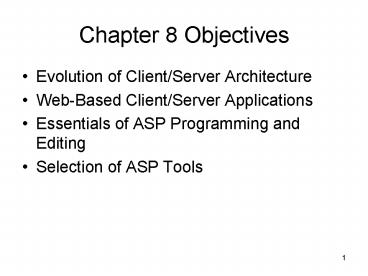Chapter 8 Objectives - PowerPoint PPT Presentation
1 / 19
Title:
Chapter 8 Objectives
Description:
Client: client computers and their software. Server: includes both ... Write a Web client/server database application with HTML and DHTML. 10. Database Layer ... – PowerPoint PPT presentation
Number of Views:23
Avg rating:3.0/5.0
Title: Chapter 8 Objectives
1
Chapter 8 Objectives
- Evolution of Client/Server Architecture
- Web-Based Client/Server Applications
- Essentials of ASP Programming and Editing
- Selection of ASP Tools
2
Client/Server Architecture
- Two components
- Client client computers and their software
- Server includes both hardware and software
Client machines send requests to server
Server processes request
Server returns results to client
3
One-Tiered Architecture
- Server mainframe or minicomputer
- Dumb terminals
- No internal processing power
- No storage capacity
- All processing, calculation, storage done on
mainframe - Disadvantages
- Single centralized processor
- Lacks flexibility and scalability
4
Two-Tiered Architecture
- Server mainframe or minicomputer
- Personal computers
- Processing tasks divided
- Applications run on PCs
- Data stored on mainframes
- Disadvantages
- Complex applications are large
- Client PCs become fat
5
Three-Tiered Architecture
- Server mainframe or minicomputer
- Personal computers
- Application server
- Middleware
- Provides applications
- Acts as transaction monitor
- Stores data
- Advantages
- Thin client
6
Web-Based Architecture
7
Web-Based Client/Server
- Advantages over LANs and WANs
- No geographic boundaries
- Accessible wherever Internet connection available
8
Browser Presentation Layer(p.186)
- Human-to-computer interface
- Possible elements
- Home page with welcome message
- Product pages with buy buttons
- Buy buttons linked to product page
- Order form
- Shipping information
9
Application Server Layer
- Middle layer
- Web server takes requests from client browser
- Forwards requests to the database
- Server collects responses from database
- Passes responses to client browsers
- Building an application server layer
- Install a Web server
- Connect the server to the Internet
- Create a virtual directory for the Web server
- Write a Web client/server database application
with HTML and DHTML
10
Database Layer
- Stores and retrieves data
- SQL requests received from Web server
- Database app stores data, processes results
- Sends results to server
- Server forwards results to client browsers
- Building a database layer
- Develop database app on the server computer
- Create DSNs for the user and system
- Or Create OLE DB (Object Linking and Embedding
Database Microsoft standard)
11
Impact of Applications
- School sites
- Registration
- Check schedules, grades, exams
- Business-to-business (B2B)
- Supply chain management
- Business-to-consumer (B2C)
- Online retailing like Amazon.com
- Consumer-to-consumer (C2C)
- Online auctions like eBay
12
Development of Applications
- Browser presentation layer
- HTML
- Application server layer
- ASP, Visual Basic, VBScript, Java, JavaScript,
Coldfusion, CGI, Perl - Database layer
- Web-enabled database software
- Access, SQL Server, Oracle
- DSNs or OLE DBs
- Enable database access through application layer
13
ASP ProgrammingStudy pp.198-203
- Secure, server-side scripting
- Viewable with any browser
- Open development environment combines
- Scripting
- Pre-built objects
- ASP delimiters lt . . .gt
- Five primary ASP objects
14
Request Object
- Purpose to get information from the user
- Submits info to Web server
- Basic data collection functions
- Form
- QueryString
- ServerVariables
- Cookies
15
Response Object
- Purpose to send information to the user
- Delivers to client browser
- Basic functions
- Changing cookies
- Controlling properties of objects
- Controlling actions of objects
16
Server Object
- Purpose to control connections to external
components - Used in nearly every ASP file
- Supports only one property
- ScriptTimeout
- Determines maximum time an ASP file can take to
complete an execution
17
Session Object
- Purpose to store information about and change
settings for the users current Web-server
session - Automatically created when new visitor arrives at
application page - Enables application to keep track of visitors
18
Application Object
- Purpose to share application-level information
and control settings for the lifetime of the
application - Created at Web server when you create a virtual
directory for the application
19
ActiveX Data Objects
- Interface with other relational databases
- Use ODBC
- Three objects
- Connection
- Recordset
- Command































